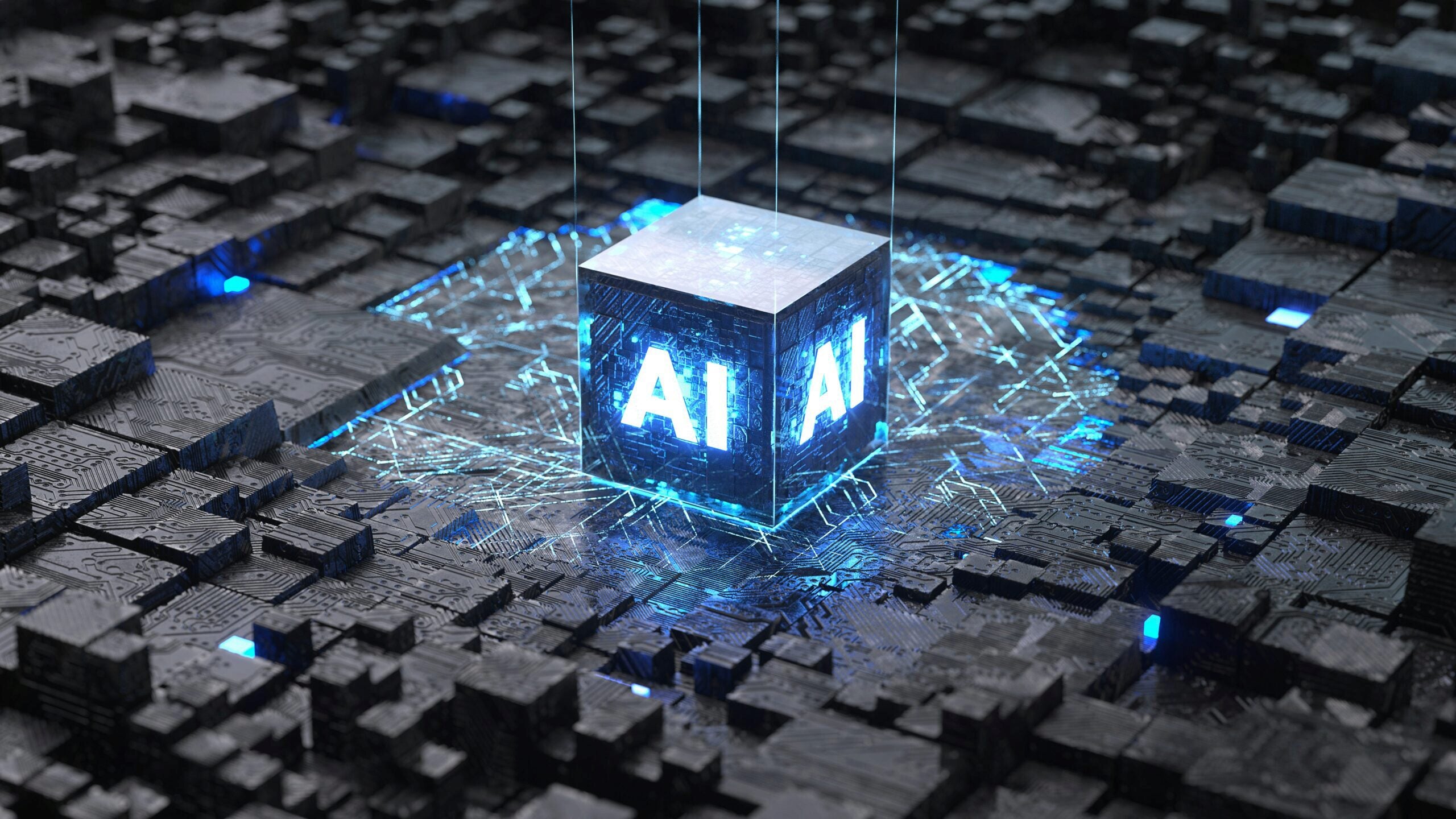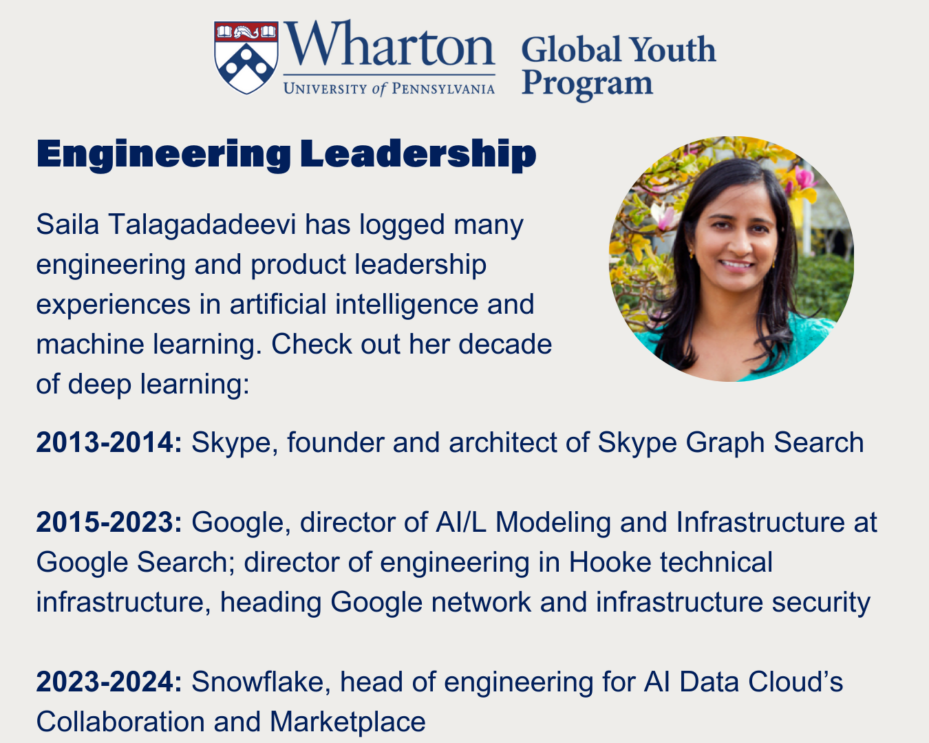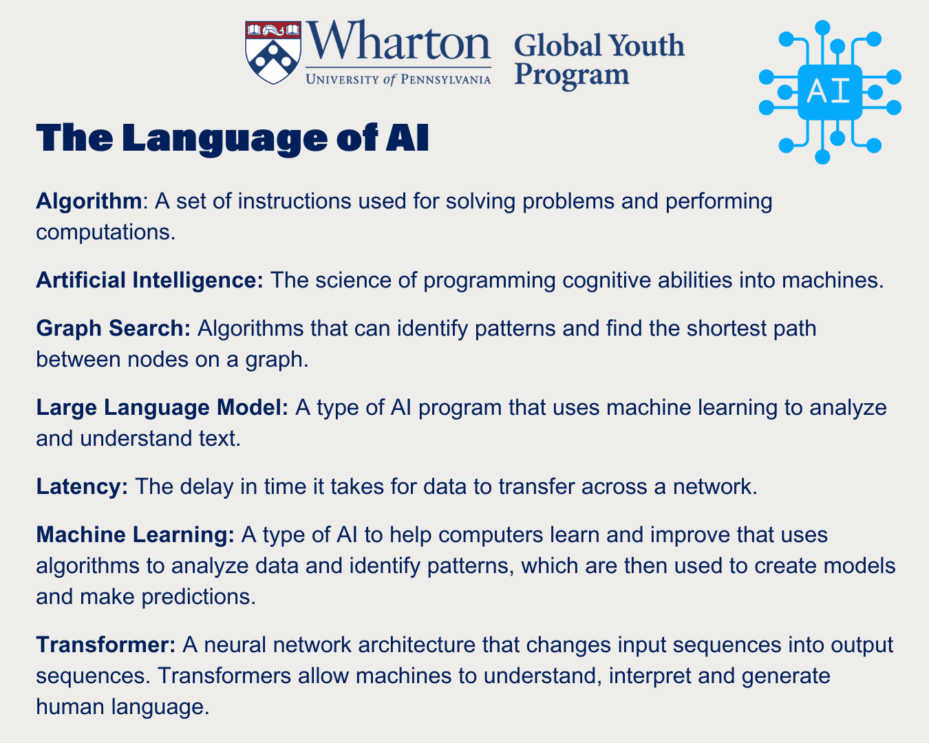5 Questions for Saila Talagadadeevi, AI and ML Trailblazer


In May 2024, the Wharton School of the University of Pennsylvania announced a major investment to drastically scale its research and teaching capabilities in artificial intelligence and data science through the new Wharton AI & Analytics Initiative.
The Wharton Global Youth Program is tuned into Wharton’s great work in this area and plans to feature more interviews and articles highlighting how AI is changing every sector of business and society.
This summer Wharton MBA and engineering leader Saila Talagadadeevi visited our Global Youth Meetup online community to talk about her long-time passion for math and physics that led to an extensive career in electrical engineering, AI and data science. Below are some edited highlights from that conversation. You can access the full interview between Wharton Global Youth’s Effie Zhou and Saila on our YouTube channel.

Wharton Global Youth: Around 2010, machine learning (ML) started becoming more mainstream. Until that point, ML, a branch of artificial intelligence that uses algorithms to analyze data and identify patterns, was more experimental. How did you embrace this new trend in 2013 when you joined Skype, one of the first communication apps to allow users to make video and voice calls, send messages and share files?
Saila Talagadadeevi: I was super excited because I had a background in ML and statistical learning…We did a lot of fun stuff at Skype. In 2013, 2014, we built the first chatbot that worked as an assistant to a celebrity. Skype had a lot of celebrity accounts, and celebrities couldn’t talk to all of [the people messaging them], so we built the chatbot.
Also, I proposed graph search [at Skype]. You all use Snapchat and Instagram pretty regularly. They are based on graph search. Who are your friends and who are their friends? When you search for somebody, if they are in your immediate network, their name will come up first. That’s all based on graph. In 2013 and 2014, only Facebook and then LinkedIn had graphs. You had to know your friend’s ID to add a name to Skype, and that could be tricky.
I said, let’s build a graph search. But in big companies, you need to get funding and resources. I built a prototype in two months, and I partnered with Bing’s infrastructure team. We took a couple millions of user data and started prototyping. I still remember the night before my demo to the senior vice president, I introduced a bug into the list intersection code. I was awake for 36 hours to debug and redo some of the code, since I was the only person working on it. After the approvals, we built Skype’s first graph search. I was excited because you could take the startup spirit to a big company and still be successful.
Wharton Global Youth: You worked in AI and ML modeling at Google. Tell us more!
Saila: The fundamental concept is that you have tons and tons of data that enters into Google. I was fascinated by the amount of data that comes into Google and how the infrastructure scaled for it. I ran Google’s network and infrastructure security, so [we were] processing petabits of data — millions of billions of packets per second — and figuring out whether it was an attack, fraud or abuse. We built a lot of machine learning into detection, which was a fulfilling project. The product that we built stopped the world’s largest attacks in the last few years.
Wharton Global Youth: Why is that data so critical?
Saila: AI is driven by the data. Yes, you have algorithms, but if you don’t have the data, all of that is meaningless. Training and tuning the data generation is very critical for the models for experimentation and optimization.
Wharton Global Youth: What emerging trends in AI and machine learning are you most excited about?
Saila: In AI, you must have heard about large language models, which are based on transformers…I believe that transformers are not the end of AI [innovation]. Overall, I think that making models more efficient – cost-efficient, time-efficient, latency-efficient are some of the things to watch for. As we invest more and more time on these models, I’m sure there will be problems we haven’t solved and people will start looking for new algorithms.
Wharton Global Youth: What advice do you have for high school students looking to pursue AI and machine learning-related work?
Saila: If you are looking at AI and ML, there are three different layers — think of them as layers of a cake. For any AI project to be successful, all these three layers are important.
The first one is the research. If you are interested in math and linear algebra — because linear algebra is the foundation for machine learning and algorithms and research – then you know you would be a great AI researcher. With research, you really want to be focusing on building those math skills and algorithms and optimizations. Transformers are not the end of AI, right? You will actually come up with new algorithms and new ways to do AI, and that is basically where I see a lot of research happening in the future.
The second layer is the infrastructure, or what we call the computing distributed systems infrastructure. You could become an electrical engineer or study computer science. You’ll be spending a lot of time on how you scale this massive data. Large learning models are massive, right? They take days or hours to train. So how do you train these models at a scale? Every time we’re looking at the problem, we’re trying to improve the speed at which it trains and the speed at which it infers – that optimization, performance tuning.
And third is the application layer. That’s where we see a lot of entrepreneurship. So, it’s interdisciplinary. You could be studying anything. You could be studying biology, or you could be studying social sciences. But if you have that foundational knowledge about AI and ML, you could leverage these models and your domain expertise to bring a beautiful product or an application to your end users. You could be a nonprofit, or you could be building a robotic surgery tool. You could do drug research, health care, or transportation. You could innovate and you could build a company.
When you enter college, you have to decide which route you are going. The depth is important. It’s a fun time to be in this area. You’re starting fresh and you have this amazing innovation that’s happening all around you. It opens up so many possibilities for you to innovate, build companies and change lives.

How does Saila Talagadadeevi demonstrate an entrepreneurial mindset?
Saila says, “You’re starting fresh and you have this amazing innovation that’s happening all around you. It opens up so many possibilities for you to innovate, build companies and change lives.” Do you have a vision for innovating with AI and machine learning? Share your story in the comment section of this article.
What questions do you have for Saila Talagadadeevi? Ask them here in the comment section!